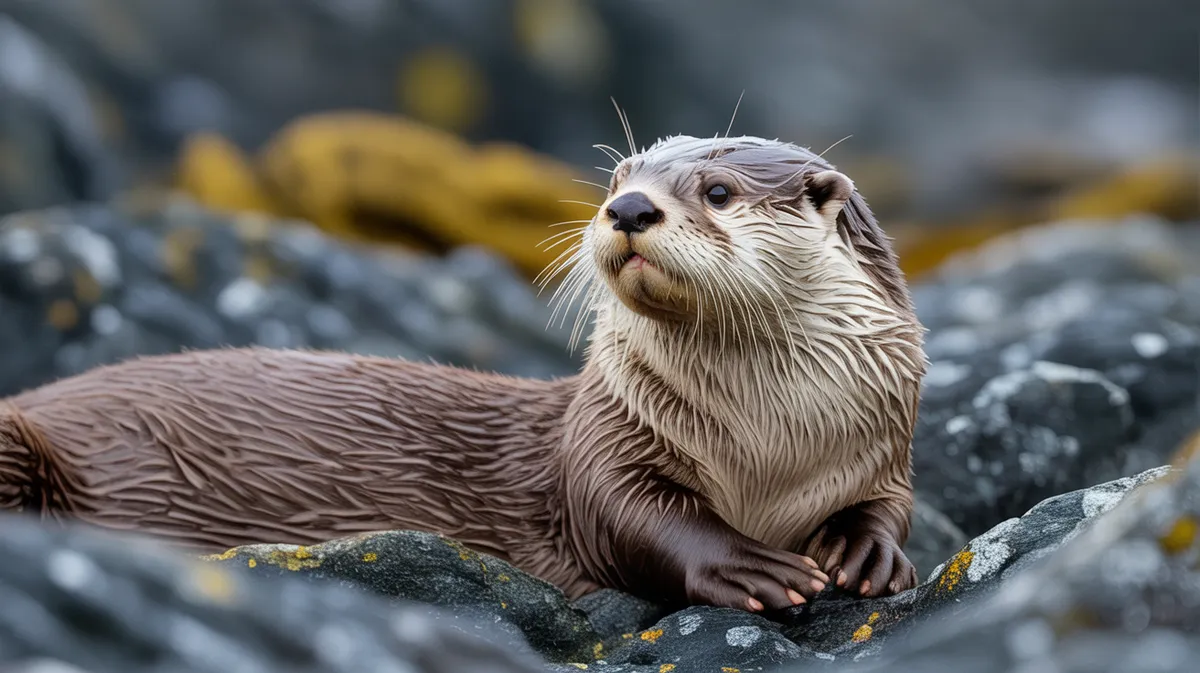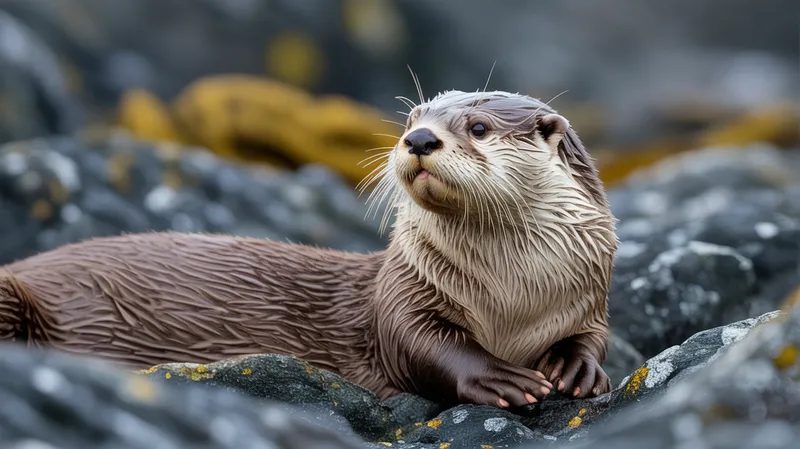
Marine Otter
Lontra felina

Meet the Marine Otter
The Marine Otter is a small, elusive otter species native to the rocky coastal regions of South America, particularly along the Pacific shores of Chile and Peru. Adapted to life in the marine environment, this otter spends most of its time in the ocean, foraging among kelp beds and rocky crevices for food. It has dense, water-repellent fur to keep it warm in chilly waters, and a slender, streamlined body ideal for swimming. Unlike most otters, the Marine Otter rarely ventures into freshwater habitats and is considered the smallest marine mammal in the world.
Classification
Mammal
Habitat
Rocky marine coastlines
Diet
Carnivore
Lifespan
10-15 years
Conservation
Endangered
Weight
3-5 kg
📖Fascinating Facts
Coastal Specialist
Marine Otters are highly specialized for life on rocky, wave-battered coasts, rarely entering rivers or estuaries.
Varied Diet
Their diet includes fish, crustaceans, mollusks, and even small birds, making them effective marine predators.
Thick Fur
They have some of the densest fur of any mammal, which helps insulate them from cold ocean waters.
📋Detailed Description
The marine otter (Lontra felina) is the smallest marine mammal, with adults typically measuring 87–115 cm in total length and weighing between 3 and 5 kg. Its body is slender and elongated, with short limbs and a flattened, muscular tail that aids in agile swimming among rocky coastal habitats. The fur is dense and velvety, consisting of a waterproof undercoat and longer guard hairs, providing insulation against cold Pacific waters. The head is small and cat-like, with a blunt snout, short whiskers, and small, rounded ears—features that contribute to its Spanish name 'gato marino' (marine cat). Unlike most otters, L. felina is almost exclusively marine, rarely entering freshwater or estuarine environments. Its coloration is generally dark brown to grayish, with a paler throat and chest. The species is highly elusive and secretive, often sheltering in rock crevices or caves along exposed, wave-battered shorelines. Marine otters are solitary or found in small family groups, and their activity is primarily diurnal, although some nocturnal foraging occurs. Their diet is diverse, including fish, crustaceans, mollusks, and occasionally birds or small mammals. The species' distribution is patchy, restricted to the Pacific coasts of Peru, Chile, and southern Argentina, with the largest populations found in southern Chile.
💡 Did you know?
Despite living in the ocean, Marine Otters never venture far from shore, often staying within 30 meters of the coastline.
🔬Research & Sources
Wikipedia Summary
The marine otter is a rare and relatively unknown South American mammal of the weasel family (Mustelidae). The scientific name means "feline otter", and in Spanish, the marine otter is also often referred to as gato marino: "marine cat". The marine otter only lives in saltwater, coastal environments and rarely ventures into fresh water or estuarine habitats. This saltwater exclusivity is unlike most other otter species, except for the almost fully aquatic sea otter of the North Pacific.
Last Modified: 5/22/2025
🎭Behavior & Social Structure
Marine otters are predominantly solitary, with adults maintaining distinct home ranges that may overlap only minimally. They are highly territorial, marking their ranges with feces and scent from anal glands. Foraging occurs mainly during daylight hours, with peak activity at dawn and dusk. They hunt in shallow coastal waters, skillfully navigating kelp beds and rocky intertidal zones to capture prey such as crabs, shrimp, fish (notably blennies and clingfish), and occasionally octopus or mussels. Unlike sea otters, marine otters rarely use tools to open hard-shelled prey, instead relying on their strong jaws and dexterous forepaws. Social interactions are most frequent between mothers and offspring, though pairs may be seen during the breeding season. Vocalizations are limited but include whistles, chirps, and growls, mainly used in mother-pup communication or territorial disputes. Resting and grooming are carried out on secluded rocks or in coastal caves, and individuals are highly vigilant, quickly retreating to cover when disturbed.
👶Reproduction & Life Cycle
Breeding in marine otters is not strictly seasonal, though most births occur between December and January in the southern hemisphere. Courtship and mating take place in the water or on secluded rocky shores. After a gestation period estimated at 60–82 days, females give birth to one or two pups (rarely three). Pups are born fully furred and with eyes closed, weighing about 150–200 grams. Maternal care is intensive; the mother nurses and protects the pups for up to 10 months, teaching them to swim and hunt. Weaning occurs gradually, and juvenile otters may remain with the mother for several months after weaning. Males do not participate in parental care and may be aggressive toward unrelated pups. Sexual maturity is reached at approximately 2–3 years of age.
🛡️Adaptations & Survival
Marine otters exhibit several adaptations for life in harsh, wave-exposed coastal environments. Their dense, water-repellent fur provides critical insulation, as they lack the thick blubber layer seen in other marine mammals. The streamlined body and powerful, flattened tail enhance swimming agility, allowing rapid maneuvering among rocks and kelp. Short, webbed feet improve propulsion in water, while strong, curved claws assist in climbing and gripping slippery surfaces. Their keen eyesight and sensitive vibrissae (whiskers) aid in detecting prey in turbid or low-light conditions. Behaviorally, they are highly secretive and use complex coastal topography for shelter and protection from predators and human disturbance. Their diet is opportunistic, enabling them to exploit a wide range of intertidal and subtidal resources.
🎨Cultural Significance
In local folklore, the marine otter is sometimes regarded as a mysterious or elusive creature, admired for its agility and playfulness. The Spanish name 'gato marino' reflects its cat-like appearance and behavior. Historically, marine otters were hunted for their pelts, which were highly valued for their softness and warmth. Today, the species is protected by law throughout its range, and it serves as a flagship species for coastal conservation efforts in Chile and Peru. The marine otter features in environmental education and ecotourism initiatives, symbolizing the unique biodiversity of South America's Pacific coastline.
🔬Recent Research & Discoveries
Recent research has focused on the genetic diversity and population structure of marine otters, revealing low genetic variability and significant population fragmentation, which heightens extinction risk. Studies using camera traps, scat analysis, and environmental DNA (eDNA) have improved knowledge of distribution, diet, and habitat use. Ongoing research aims to assess the impacts of fisheries, pollution, and climate change on otter populations. Conservation projects are investigating the effectiveness of marine protected areas and community-based stewardship in safeguarding critical habitats. Notably, a 2022 study documented the first confirmed use of artificial dens by marine otters, suggesting potential for habitat enhancement in restoration efforts.
🎥Wildlife Videos

How Otters Survive In The Rocky Mountains | River Masters | Real Wild
In remote regions of the Rocky Mountains of the United States, the river otter still thrives. They live in the lakes and rivers where ...
Real Wild

Hungry, Hungry Sea Otters: The Big Appetites Saving Coastlines | WILD HOPE
Sea otters are back, and their return is a breath of fresh air for the waters of Monterey Bay. Marine ecologists Brent Hughes and ...
Nature on PBS

Hungry, Hungry Otters | Destination WILD
About National Geographic Wild: National Geographic Wild is a place for all things animals and for animal-lovers alike. Take a ...
Nat Geo Animals

Otters : The best Fishermen of Rivers ! Life journey of otters ! Wildlife Documentary
TheWildlifeScience

Amazing Otter Moments | BBC Earth
Otters are a member of the weasel family and can be found on every continent except Australia and Antarctica. They may be cute ...
BBC Earth

How The River Otter Survives Coyotes And Eagles | OTTERS RIVER MASTERS OF YELLOWSTONE | Wild Waters
River otters thrive in the remote corners of the Rocky Mountains, facing few natural predators except for coyotes. They primarily ...
Wild Waters - Animal Documentaries
🌍Habitat Information
The Marine Otter typically inhabits Rocky marine coastlines environments. Marine Otters have adapted to their environments with specialized features and behaviors.
Primary Habitat:
Rocky marine coastlines
More detailed habitat information will be available soon.
🛡️Conservation Status
The Marine Otter is currently classified as Endangered. Conservation efforts are crucial for preserving this species for future generations.
Common Threats:
- 🏠Habitat loss and fragmentation
- 🌡️Climate change impacts
- 🎯Hunting and poaching
- 🏭Human-wildlife conflict
⚠️Threats & Conservation Challenges
The marine otter is classified as Endangered due to a combination of factors. Habitat loss and fragmentation from coastal development, pollution, and disturbance from tourism and fishing activities are major threats. Accidental entanglement in fishing gear (bycatch), direct hunting for fur (historically significant), and competition with humans for fish and shellfish resources further impact populations. Oil spills and marine pollution pose additional risks, as otters rely on clean fur for thermoregulation. Population estimates suggest fewer than 3,000 individuals remain, with ongoing declines in many areas. Conservation is complicated by the species' secretive nature, patchy distribution, and the inaccessibility of much of its habitat.
🔬Scientific Classification
Scientific Name
Lontra felina
Classification Hierarchy
🔍 About Taxonomic Classification
Taxonomic classification is a hierarchical system used by scientists to classify and organize living organisms based on shared characteristics and evolutionary relationships.
The system moves from broad categories (Kingdom) to increasingly specific ones, with each animal's scientific name typically consisting of its Genus and species.
📝Community Notes
Share your observations and insights about the Marine Otter with our community of wildlife enthusiasts.
Join Our Community
Sign in to share your observations and connect with fellow wildlife enthusiasts.
Sign In to ContributeNo community notes yet
Be the first to share your observations about the Marine Otter!
Explore Marine Otter
Select a tab above to learn more about this amazing animal.
📸Photo Gallery
No photos available for this animal yet.
🌟Discover More Wildlife
Continue your journey of discovery with more fascinating animals from our database
